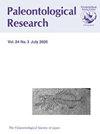Early Berriasian to Early Barremian Calcareous Nannofossils Biostratigraphy and Paleoecology of Baghamshah Formation (Esfandiar Section, Tabas Block), Eastern Iran
IF 0.6
4区 地球科学
Q3 PALEONTOLOGY
引用次数: 0
Abstract
Abstract. The Baghamshah Formation was previously assigned to Jurassic age in Iran, based on stratigraphic distribution of ammonites. But, recent studies of calcareous nannofossils in the Lut Block show that the age of this formation should be assigned to the Early Cretaceous (early Berriasian to early Barremian). This study analyzed stratigraphic distribution of calcareous nannofossils of the Baghamshah Formation in the Esfandiar section located in the southeast of the Tabas Block (close to the type section). Examinination of samples identified 39 calcareous nannofossil and 6 didemnid ascidian spicules species belonging to 19 genera, corresponding from CC1 to CC5 biozones with the age of early Berriasian to early Barremian. Index nannofossil species in the succession indicate that the sedimentary basin of the Baghamshah Formation in the Esfandiar section was located in low latitudes of the Tethyan realm with warm surface water toward the top of the section. Also, the oceanic basin was an oligotrophic type with low-fertility, as its nutrient supply dropped toward the top of the section. The oligotrophic paleoenvironment during the late Berriasian to early Valanginian in the study area in eastern Iran may have corresponded to a global low sea-level.伊朗东部Baghamshah组(Tabas地块Esfandiar段)早贝里西亚-早巴雷米安钙质超微化石生物地层学和古生态
摘要根据菊石的地层分布,Baghamshah组以前在伊朗被划分为侏罗纪。但是,最近对Lut地块钙质超微化石的研究表明,该地层的年龄应归属于早白垩纪(早贝里西亚-早巴雷米亚)。本研究分析了位于塔巴斯地块东南部的Esfandiar剖面(靠近模式剖面)中Baghamshah组钙质超微化石的地层分布。样品鉴定鉴定了19属39种钙质超微化石和6种二足目海鞘棘化石,对应于CC1至CC5生物带,年龄为早贝里西亚至早巴雷米亚。序列中的指数超微化石物种表明,Esfandiar剖面Baghamshah组的沉积盆地位于特提斯地区的低纬度地区,剖面顶部有温暖的地表水。此外,洋盆是一种贫营养型,肥力低,因为其营养供应向剖面顶部下降。伊朗东部研究区贝里亚世晚期至瓦兰吉世早期的贫营养古环境可能与全球低海平面相对应。
本文章由计算机程序翻译,如有差异,请以英文原文为准。
求助全文
约1分钟内获得全文
求助全文
来源期刊

Paleontological Research
PALEONTOLOGY-
CiteScore
1.60
自引率
0.00%
发文量
47
审稿时长
>12 weeks
期刊介绍:
Paleonotological Research (PR) is a quarterly, peer-reviewed international journal, which focuses on original contributions primarily in the area of paleontology but also covering a wide range of allied sciences. It has been published since 1997 as a successor to the former journal Transactions and Proceedings of the Palaeontological Society of Japan. The emphasis of contributions will include global and local perspectives, and contents can cover all ages (Precambrian to the Quaternary, including the present time).
 求助内容:
求助内容: 应助结果提醒方式:
应助结果提醒方式:


